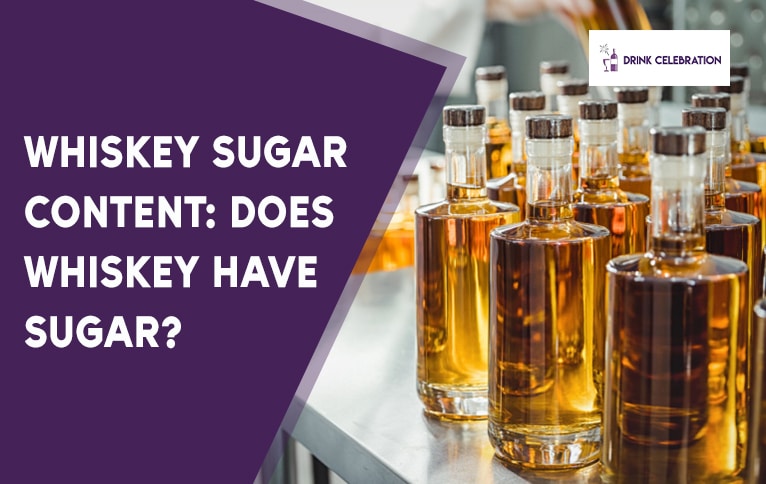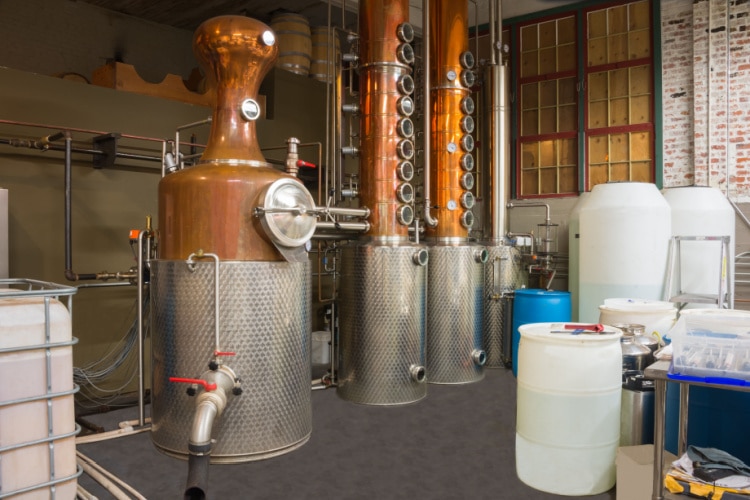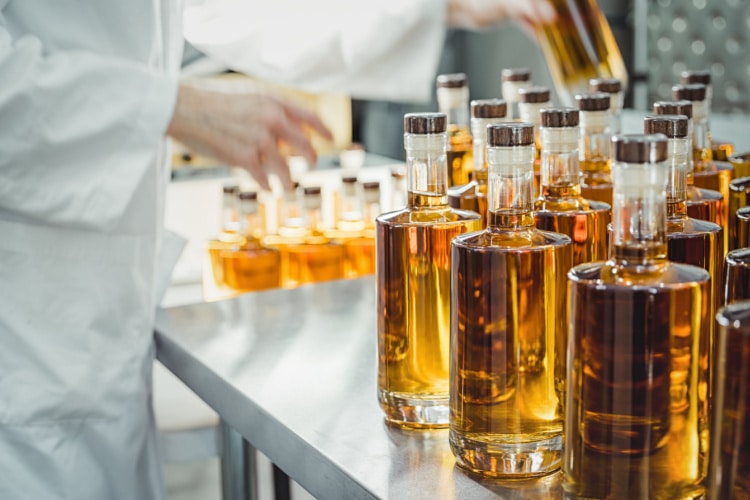Whether you prefer to sip your whiskey neat, on the rocks, or mixed into a cocktail, there’s no denying that this sophisticated libation has a certain allure that you just don’t find in other liquors.
While enjoying its complex palette of flavors and the smooth, warm finish, have you ever wondered, “Does whiskey have sugar?”

The short answer is no, despite sugar being a fundamental piece of the fermentation process.
The Whiskey Production Process

Before discussing sugar’s role in whiskey-making, let’s set the stage with insights into how this centuries-old spirit gets made.
Ingredients
It might come as a surprise to learn that, despite all of the richness and complexity of whiskey, it consists of three essential ingredients: grain, yeast, and water.
Distillers vary the grain bill– the ratio of corn, wheat, oats, barley, and rye– to achieve a particular flavor profile and determine the type of whiskey they’re making.
These grains are also the source of whiskey’s sugar content, as all plants have naturally-occurring sugars that they produce through photosynthesis and use as their food source.
Malting and Mashing
The first step of scotch whisky and malt whiskey production is malting, in which the distiller soaks barley in water to allow it to start germinating and produce hydrolytic enzymes that convert the grain’s inner starch and protein reserve into maltose sugar.
Distillers then dry and grind the sprouted barley into a grist.
American whiskey doesn’t undergo malting, but its high corn content–at least 51% of the grain bill– achieves a similar sugar presence.
Regardless of the type, the next step (or first step, in the case of bourbon) is mashing, during which the grist mixes with warm water to extract more of the sugars from the grain. This step produces a sugar-rich liquid called wort and distiller’s grains.
The spent distiller’s grains are filtered out and reused for protein-rich animal feed, while the wort heads into a washback vessel for the next phase of the process.
Fermentation
During fermentation, distillers add yeast to the sugar-laden wort to kick off its transformation into whiskey.
Yeast feeds on the extracted sugars in the wort, and as they metabolize, they undergo anaerobic respiration. This chemical process converts sugars into ethanol and carbon dioxide, turning the wort into the wash.
However, anaerobic respiration conversions are not perfectly efficient, so some unfermented sugars are always left behind in the wash. It’s also still relatively low in alcohol content, a problem solved during distillation.
Distillation
Distillation works on the principle that different compounds boil at different temperatures, so distillers use it to concentrate the alcohols and reduce the unwanted water and sugars.
During primary or wash distillation, the wash heads into copper stills to be boiled. The heat causes the alcohol to evaporate at a lower temperature than the water and sugar. As the alcohol vapors rise up through the neck of the still, most of the water and sugar are left behind.
As the newly concentrated alcohol cools, it condenses back into a liquid called low wine in the aptly-named condenser before secondary or spirit distillation can begin.
Spirit distillation requires boiling the low wine into three components:
- The head consists of the most volatile compounds that boil off first– methanol.
- The heart is the high-proof, clear spirit that will eventually become whiskey.
- The tail, or any excess sugars that boil at higher temperatures and stay behind in the still once the head and heart have evaporated off.
The heart is the only substance distillers are interested in, so it moves on to the final step.
Maturation
At the point at which the heart heads into wooden barrels to mature, the sugar content is almost non-existent.
However, the maturing spirits will absorb certain compounds from the wood that give it complex flavor profiles, depending on the type of wood and whether it’s been toasted or charred.
For example, the American white oak barrels used for bourbon impart hints of honey, vanilla, and cinnamon, giving it a light sweetness without adding sugars.
Similarly, charring or toasting the barrel breaks down the wood into flavor compounds called tannins, which the fiery distillate absorbs as it mellows into the sweet, sippable spirit we enjoy in our whiskey glass.
It’s worth restating, though: these flavor and aroma profiles are not the result of adding sugar.
Instead, they come from the naturally-occurring plant terpenes and ketones like vanillin (vanilla flavors), limonene (citrus flavors), and linalool (floral flavors).
How Different Types of Whiskey Get Their Sweetness

Whiskey is a broad category of spirits, from scotch’s peaty-smokiness to the distinctive rye whiskey spice.
So, if there’s almost zero sugar in whiskey, why would different types of whiskey have varying sweetness levels?
It comes down to the type of grain that goes into the mash and how it’s matured.
- Bourbons must have a grain bill with at least 51% corn, be aged in new, charred oak barrels, and cannot have any additives. The higher corn content tends to give bourbon a natural sweetness without added sugars, while the charred oak, as mentioned earlier, lifts the flavors with hints of vanilla and honey.
- Canadian and American rye whiskey is less sweet than bourbon and instead has a nose-tingling spiciness from the addition of rye in the grain bill.
- Scotch whisky, hailing from Scotland, has a range of sweetness levels depending on whether it’s a single malt, blended malt, single grain, or blended grain. The malted barley of all scotch gives it more perceived sweetness, though it’s balanced by a deep smokiness from barley dried over peat fires before heading into the mash.
- Irish whiskey is impeccably smooth thanks to its triple distillation process that removes even more of the barely-there sugars leftover after spirit distillation.
Exceptions to the Rule
Just because whiskey doesn’t contain sugar doesn’t mean there aren’t exceptions to the rule. As with any liquor, flavorings, and additives can turn this sugar-free spirit into a sticky sweet shadow of its former self.
Flavored Whiskeys
After maturation, some distillers add syrups, extracts, and artificial flavoring to their whiskey to create flavored whiskies.
For example, Fireball Cinnamon Whisky contains a significant amount of sugar at 11 grams per 1.5 ounces due to the added sweeteners.
Whiskey Cocktails
Similarly to flavored whiskies, the high sugar content of whiskey cocktails stems from the additives, not the whiskey itself.
Take, for instance, the classic Old Fashioned, which contains sugar as one of its three pillar ingredients alongside bourbon and Angostura bitters. Add a maraschino cherry, and you’re looking at around 6 grams of sugar.
Not too bad!
However, you may want to stop after just one spiked eggnog, as depending on the recipe, it can contain around 18 grams of added sugars in a half-cup serving.
Evan WilliamsWilliam’s Original Southern Egg Nog ups the ante even more with 21 grams of sugar for a serving. That adds up quickly, especially if you’re too wrapped in the festivities to realize how many cups you’ve had.
Conclusion
So, there you have it! Whiskey is a virtually sugar-free spirit that gets its natural sweetness from the plant-based flavor compounds in the grain bill and the wooden barrels it ages in.
While the distillation process removes the vast majority of naturally occurring sugars in whiskey’s grain bill, it’s best to enjoy it as-is if you’re trying to avoid drinking too many of your daily calorie allotment.
If you prefer a flavored drink, you can also try some low-calorie whiskey cocktail alternatives– like swapping out Coke for Diet Coke.
Salud!